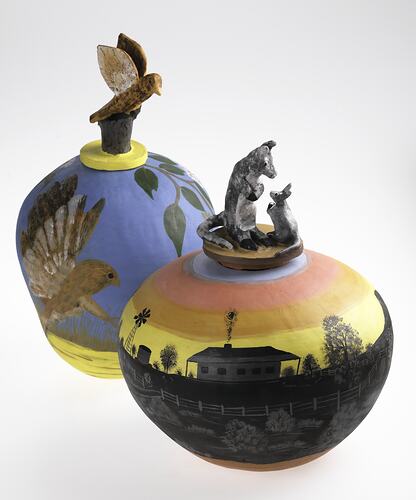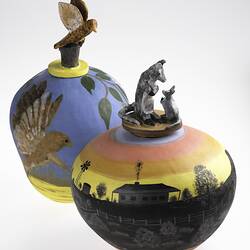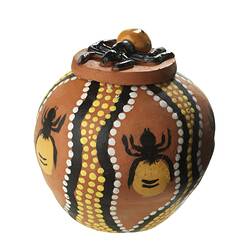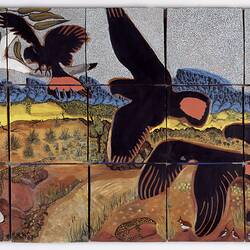The Western Arrernte community of Ntaria (Hermannsburg) is based at the remote foothills of the Western MacDonnell ranges in Central Australia. The Hermannsburg Aboriginal Mission was established there in 1877 by two Lutheran missionaries. The arts were strongly encouraged at the mission and pottery was introduced in the early 1970s by Victor Jaensch who built a small kiln and advised on sourcing local clay and the hand-coil technique for making ceramic pots. Two Arrernte teaching assistants, Nashasson Ungwanaka and Joseph Rontji, learnt the art and began the tradition of making sculptures from clay.
The mission land was returned to the traditional Arrernte owners in 1982. In 1990 Nashasson Ungwanaka invited potter and teacher Naomi Sharp to Hermannsburg to teach pottery and the Hermannsburg Potters Aboriginal Corporation was established. Initially both men and women produced pottery however over time women became the principal pottery makers. Pottery is an important part of the life of many women in the community: 'we sit around talking as we make our pots, with the younger ones learning from the older ladies about pottery and life.and because the centre is women's only, the ladies feel comfortable talking about important issues' notes Judith Inkamala.
The distinctive sculptured terracotta pots produced by the Hermannsburg Potters are made using the hand-coil technique. Coils are rolled from the clay, and the artists build up their pots slowly, pinching the rim of the pot, coil on coil. When the form is complete, the surface is smoothed and shaped with a wooden paddle, and then burnished with the back of a metal spoon. Once the pots are dry, they are glazed and then fired. In addition to individual pots, the artists are frequently commissioned to produce large ceramic relief tile murals for Australian and International clients.
The vibrant and highly original art produced by the Hermannsburg Potters draws on many influences. Particularly the artwork reflects the strong history of Hermannsburg visual culture and story-telling, such as Albert Namatjira's depiction of country and his modern use of style. Many of the present day potters are associated with Namatjira either directly or by kinship. The pots are decorated with designs of birds, animals, plants, people and historical and contemporary scenes, which are hand-moulded onto the lids as well as painted onto the body of the pots. The artists adapt their own stories to the ceramics, depicting their country as seamless landscapes around the pots. For senior artist Judith Inkamala pottery is a way for women to express their culture: 'when we think about a pot's design, we look around and gain inspiration from the country around us; people walking down by the river, the stories my parents told me, animals like black cockatoos, lizards and other bush tucker.'
References
Hermannsburg Potters shaping pottery and lives, 25 Feb 2014. Available from: http://www.indigenous.gov.au/hermannsburg-potters-shaping-pottery-and-lives [accessed 9 July 2015].
History of Hermannsburg, 2015. Available from: http://hermannsburgpotters.com.au/about/history-of-hermannsburg/ [accessed 9 July 2015].
The Hermannsburg Potters, 2015. Available from: http://hermannsburgpotters.com.au/about/the-hermannsburg-potters/ [accessed 9 July 2015].
Isaacs, J, 2000, The Hermannsburg Potters: Aranda Artists of Central Australia, Craftsman House, Sydney.
More Information
-
Keywords
-
Authors
-
Article types





